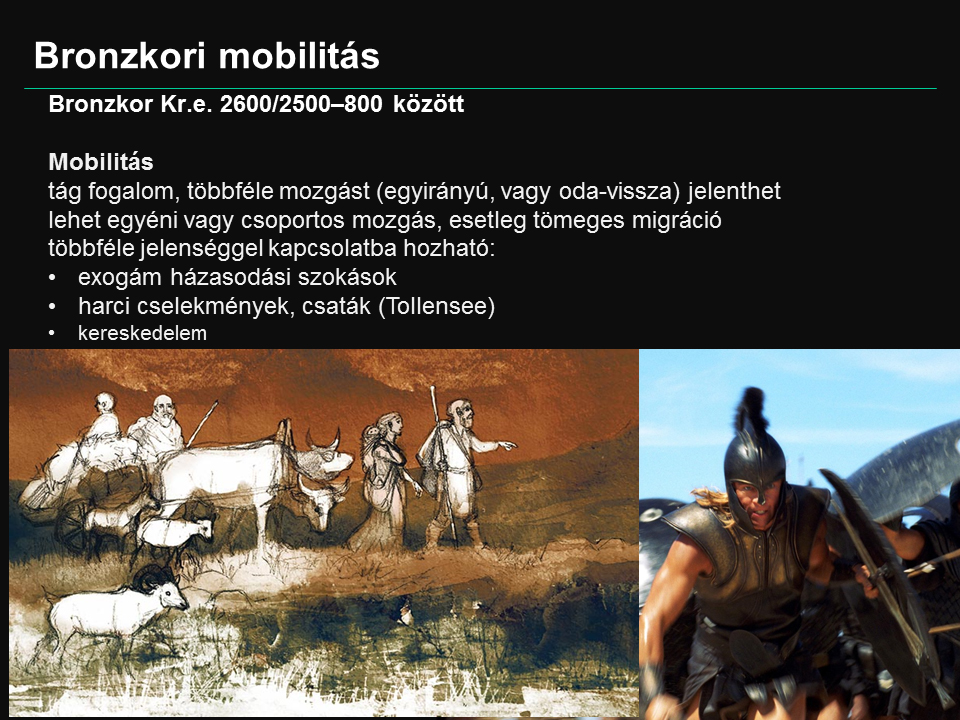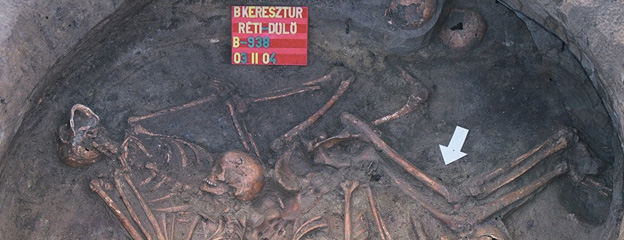Mobility and exchanges in the Bronze Age
Migration (changing the domicile of people in the hope of more favorable living conditions) is one of the most current political and social issues of our day. However, not only researchers of contemporary societies are into exploring the causes of international movements: historical wanderings are at the center of the attention of historians and archaeologists as well (see e. g. the conference organized by the Trianon 100 Lendület/Momentum Research Group this year: ON THE ROAD – Escape, Mobility and Integration after World War I in Central Europe).
Archaeological researchers – especially those examining prehistoric communities without written sources – commonly traced certain changes in material culture back to the emergence of new peoples from the very beginning. With the broad use of scientific methods in archeology recently, revolutionarily high quality and quantity of information has emerged in this area as well. The detailed (e.g. isotope) analysis of raw materials or human remains can provide us a much more subtle picture of the drivers of changes (exchange networks, cultural impacts, mobility of individuals/communities).
Most recent stable isotope (Price et al., 2004; Gerling et al., 2012; Giblin et al., 2013; Parker Pearson et al., 2016; Grupe et al., 2017) and archaeogenetic studies (Gamba et al. (see also Mathieson et al, 2015, Van der Linden 2016, Gruppe et al 2017, Kristiansen et al 2017) concerning in the 3rd and 2nd millennium BC Central Europe show that the diffusion of archaeological cultures can be linked to actual movements of people. Regarding the northern and western regions of Central Europe, similar analyses suggest that exogamous marriage was a common social norm at that time (Price et al., 2004; Frei et al., 2015; Knipper et al. 2017). According to recent data from the British Isles, almost every third person was buried far away from their place of birth around 2500 BC. Immigrants were not only women, but men, young and elderly people also. The presence of the latter may refer not only to exogamous marriage systems, but also to the migration of entire families/kins (Parker Pearson et al., 2016; Olalde et al. in print).
Our research team faces a number of issues regarding the precise processes of eastwards and westwards migrations affecting the Bronze Age Carpathian Basin as well. How exactly did long-distance trade ware (raw materials like copper, tin, gold, amber) get here? Could the appearance of new settlers be related to exogamous marriage strategies or could we rather look for wandering families and small communities?
In her lecture held on January 31 (2018), Viktória Kiss explained the most recent pan-European and Hungarian research results and mobility strategies by analysing basic case studies. In our next series of posts, we will present the methods and the latest results of research concerning Bronze Age mobility in Europe.
Stay tuned!

Illustration: Prehistoric migration uncovered with the help of DNA; Troy (movie, Warner Bros.)
References
Allentoft, M.E., Sikora, M., Sjögren K-G., Rasmussen, M. et al.: Population genomics of Bronze Age Eurasia. Nature 522 (2015) 167–172.
Childe, V. G.: Prehistoric Migrations in Europe. Oslo 1950.
Frei, K. M., Villa, C., Jørkov, M. L., Allentoft, M. E., Kaul, F., Ethelberg, P., Reiter, S. S., Wilson, A. S., Taube, M., Olsen, J., Lynnerup, N., Willerslev, E., Kristiansen, K., Frei, R.: A matter of months: High precision migration chronology of a Bronze Age female. PLoS ONE 12 (2017) e0178834. https://doi.org/10.1371/journal.pone.0178834.
Gamba, C., Jones, E.R., Teasdale, M.D., McLauphlin, L.R.: Genome flux and stasis in a five millennium transect of European prehistory. Nature Communications 5:5257. doi: 10.1038/ncomms6257
Gerling, C., Bánffy, E., Dani, J., Köhler, K., Kulcsár, G., Pike, A., Szeverényi, V., Heyd, V.: Immigration and transhumance in the Early Bronze Age Carpathian Basin: the occupants of a kurgan. Antiquity 86 (2012) 1097–1111
Giblin, J. I., Knudson, K. J., Bereczki, Zs., Pálfi, Gy., Pap, I.: Strontium isotope analysis and human mobility during the Neolithic and Copper Age: a case study from the Great Hungarian Plain. Journal of Archaeological Science 40 (2013) 227–239.
Grupe, G., Grigat, A., McGlynn, G.C.: Across the Alps in Prehistory. Isotopic mapping of the Brenner Passage by Bioarchaeology. Cham 2017.
Knipper, C., Mittnik, A., Massy, K., Kociumaka, C., Kucukkalipci, I., Maus, M., Wittenborn, F., Mezt, S., Staskiewicz, A., Krause, J., Stockhammer, P.W.: Female exogamy and gene pool diversification at the transition from the Final Neolithic to the Early Bronze Age in central Europe. PNAS 114 (2017) 10083–10088.
Kristiansen, K., Allentoft, M. E., Frei, K. M., Iversen, R., Johannsen, N. N.; Kroonen, G., Pospieszny, L., Price, T. D., Rasmussen, S., Sjögren, K-G; Sikora, M., Willerslev, E.: Re-theorising mobility and the formation of culture and language among the Corded Ware Culture in Europe. Antiquity 91 (2017) 334-347.
Mathieson, I., Lazaradis, I., Rohland, N., Mallick, S., Patterson, N., Alpaslan Roodenberg, S., Hardney, E. et al.: Genome-Wide Patterns of Selection in 230 Ancient Eurasians. Nature 528 (2015) 499–503.
Olalde, I., Brace, S., Allentoft, M.E., Armit, I., Kristiansen, K., Rohland, N., Mallick, S., Booth, T., Szécsényi-Nagy, A., Mittnik, A., Altena, E., Lipson, M., Lazaridis, I., Patterson, N.J., Broomandkhoshbacht, N., Diekmann, Y., Faltyskova, Z., Fernandes,D.M., Ferry, M., Harney, E., de Knijff, P., Michel, M., Oppenheimer, J., Stewardson, K., Barclay, A., Alt, K.W., Fernández, A.A., Bánffy, E., Bernabò-Brea, M., Billoin, D., Blasco, C., Bonsall, C., Bonsall, L., Allen, T., Büster, L., Carver, S., Navarro, L.C., Craig, O.E., Cook, G.T., Cunliffe, B., Denaire, A., Egging Dinwiddy, K., Dodwell, N., Ernée, M., Evans, C., Kuchařík, M., Farré, J.F., Fokkens, H., Fowler, C., Gazenbeek, M., Pena, R.G., Haber-Uriarte, M., Haduch, E., Hey, G., Jowett, N., Knowles, T., Massy, K., Pfrengle, S., Lefranc, P., Lemercier, O., Lefebvre, A., Maurandi, J.L., Majó, T., McKinley, J.I., McSweeney, K., Mende B. G., Modi,A., Kulcsár, G., Kiss,V., Czene, A., Patay, R., Endródi, A., Köhler, K., Hajdu, T., Cardoso, J.L., Liesau, C., Parker Pearson, M., Włodarczak, P., Price, T.D., Prieto, P., Rey, P-J., Ríos, P., Risch, R., Rojo Guerra, M.A., Schmitt, A., Serralongue, J., Silva, A.M., Smrčka, V., Vergnaud, L., Zilhão, J., Caramelli, D., Higham, T., Heyd, V., Sheridan, A., Sjögren, K-G., Thomas, M.G., Stockhammer, P.W., Pinhasi, R., Krause, J., Haak, W., Barnes, I., Lalueza-Fox, C., Reich, D.: The Beaker Phenomenon And The Genomic Transformation Of Northwest Europe. Nature in press.
Parker Pearson, M., Chamberlain, A., Jay, M., Richards, M., Sheridan, A., Curtis, N., Evans, J., Gibson, A., Hutchison, M., Mahoney, P., Marshall, P., Montgomery, J., Needham, S., O’Mahoney, S., Pellegrini, M., Wilkin, N.: Bell Beaker people in Britain: migration, mobility and diet. Antiquity 90 (2016) 620-637.
Price, T.D., Knipper, C., Grupe, G., Smrcka, V.: Strontium Isotopes and Prehistoric Human Migration, The Bell Beaker Period in Central Europe. European Journal of Archaeology 7 (2004) 9–40.
Vander Linden, M.: Population history in the third millennium BC Europe: assessing the contribution of genetics. World Archaeology 2016, 714-728.








